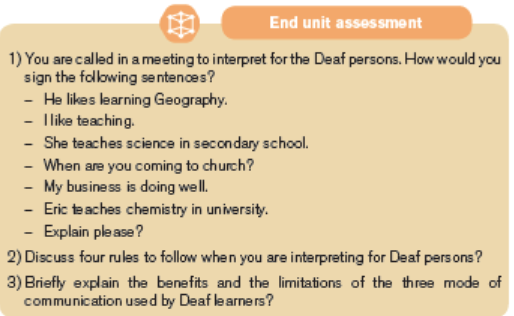UNIT 7: ADVANCED RWANDAN SIGN LANGUAGE&DEAF EDUCATION
Key Unit Competence:
Students should be able to use and interpret Rwandan Sign Language at
advanced level, and teaching approaches for the Deaf and Hard-of-hearinglearners.

7.1. Advanced Rwanda Sign Language vocabulary
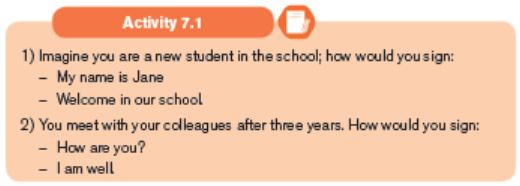
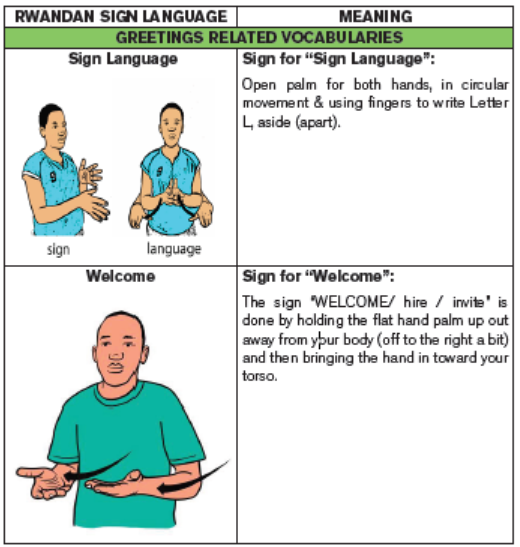
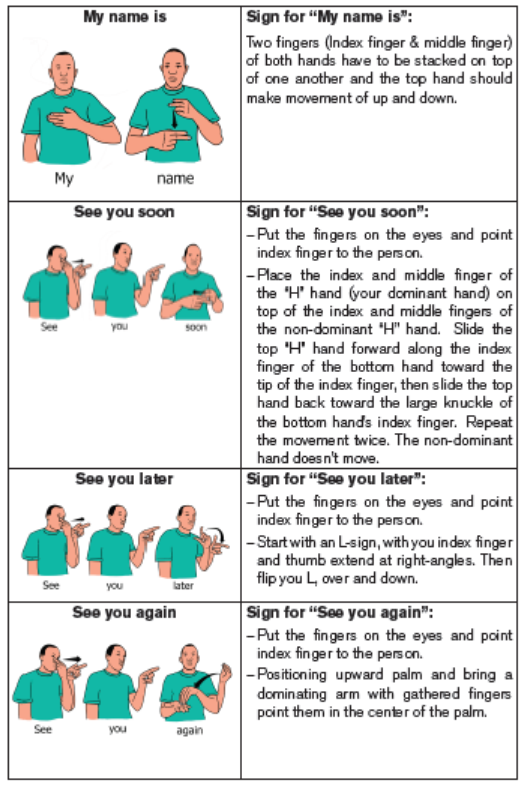
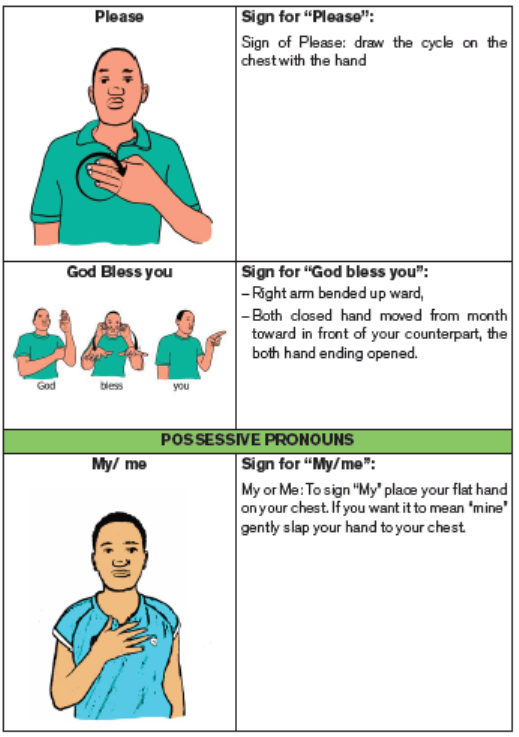
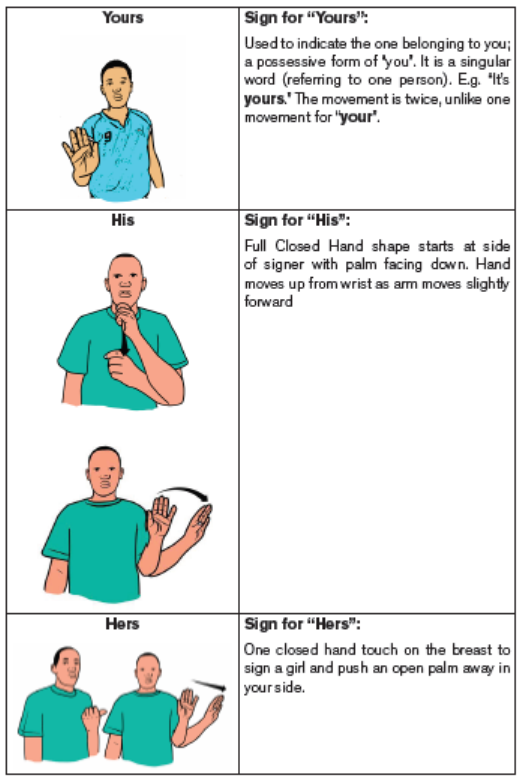
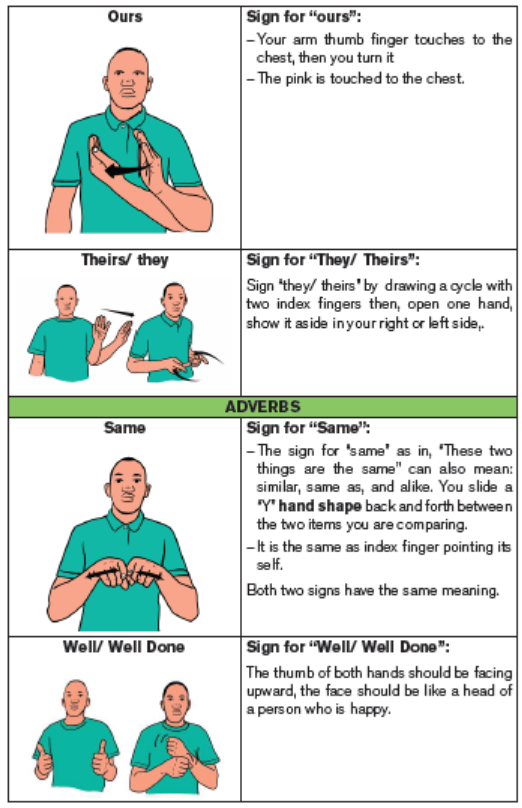
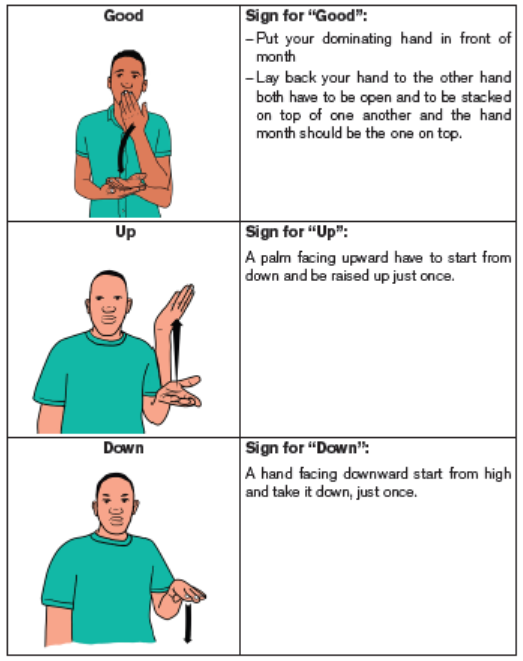
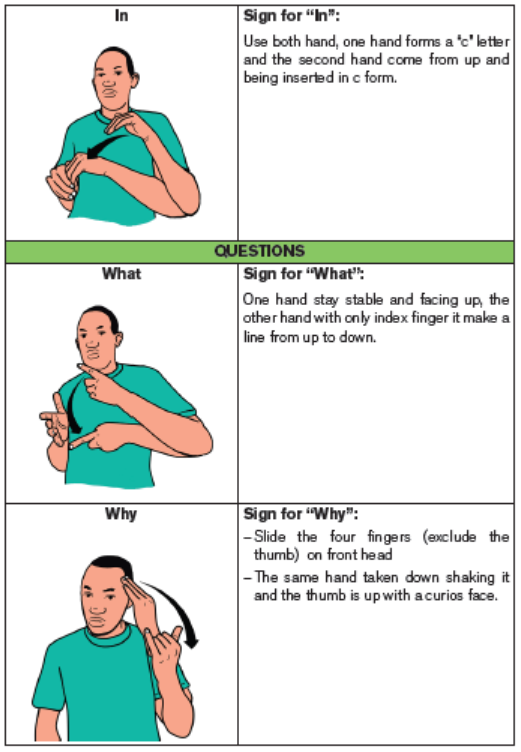
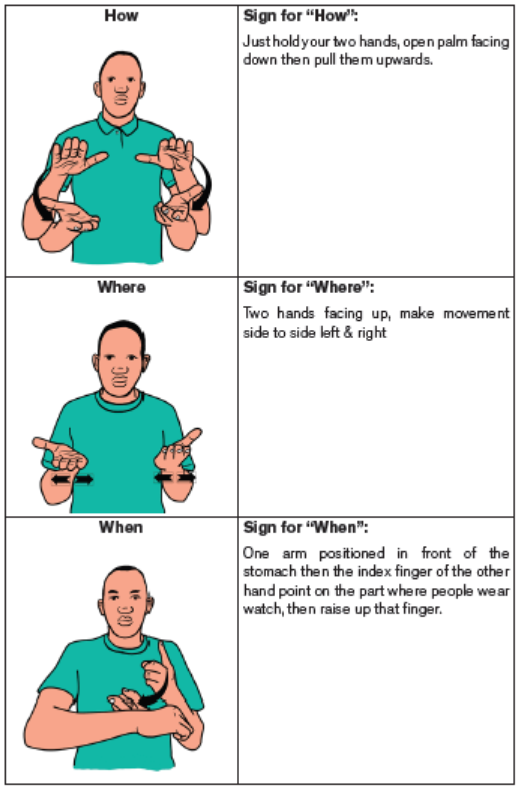
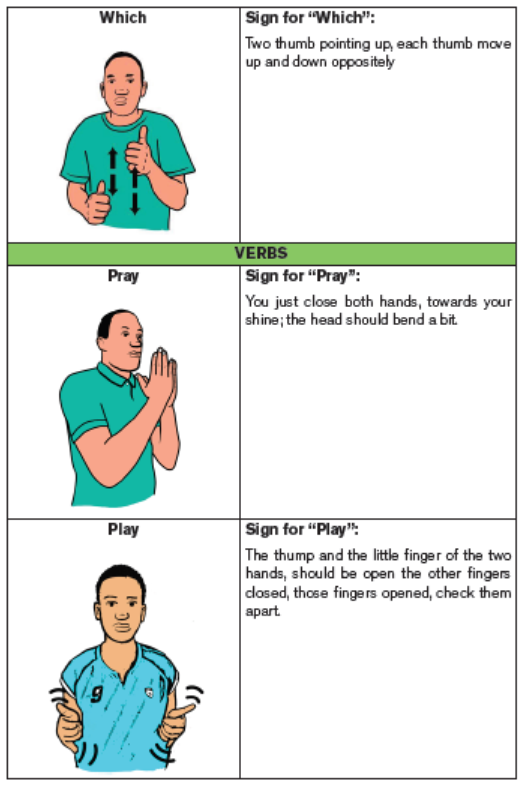
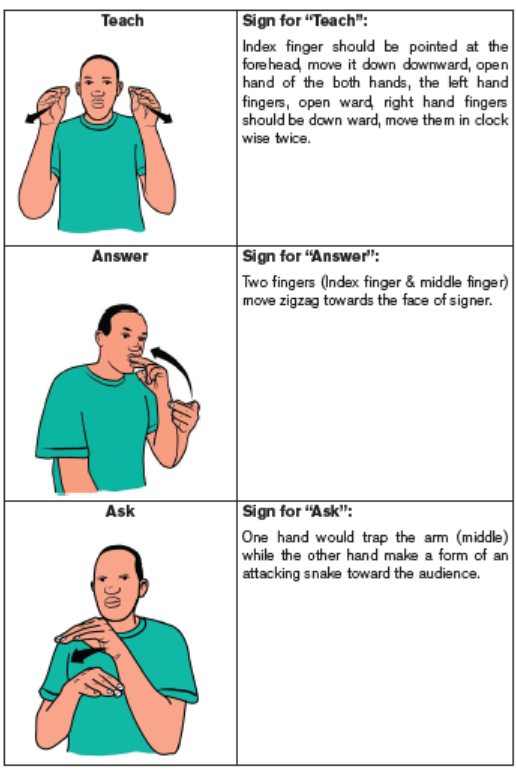
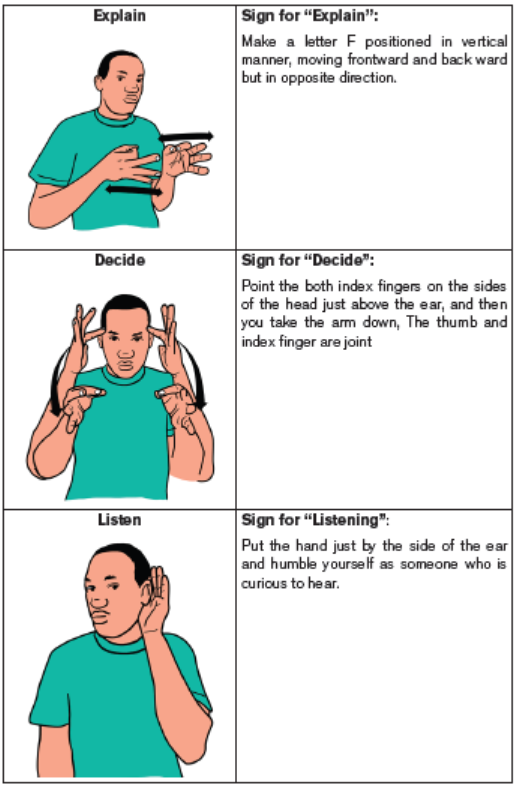
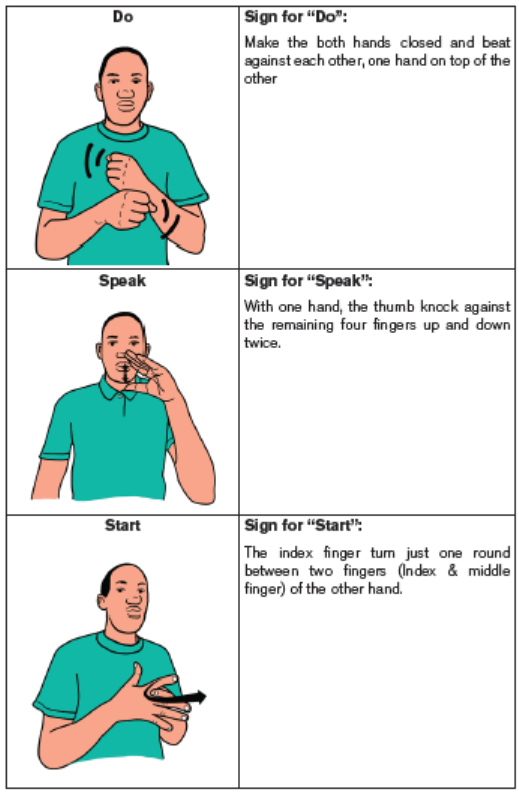
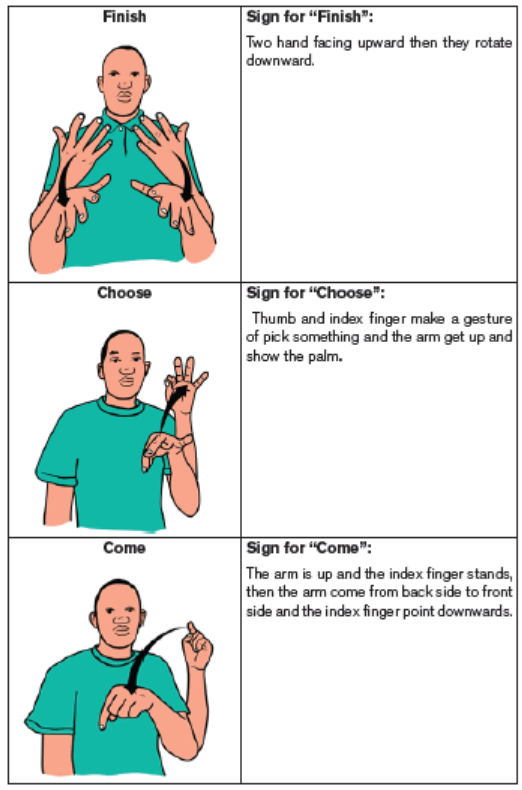
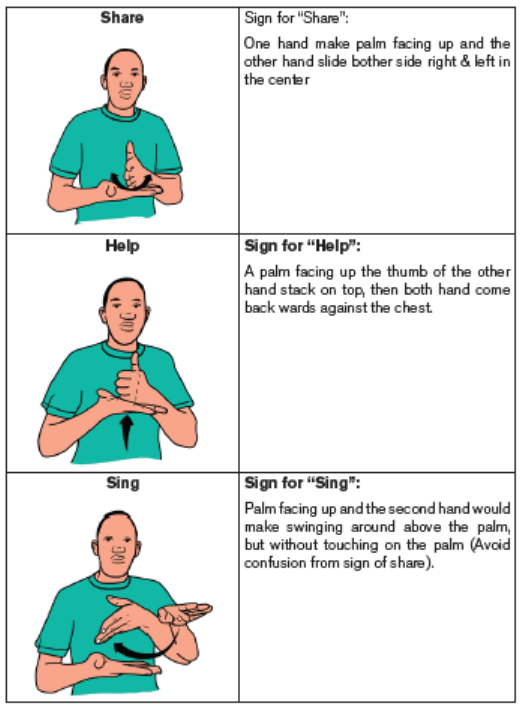
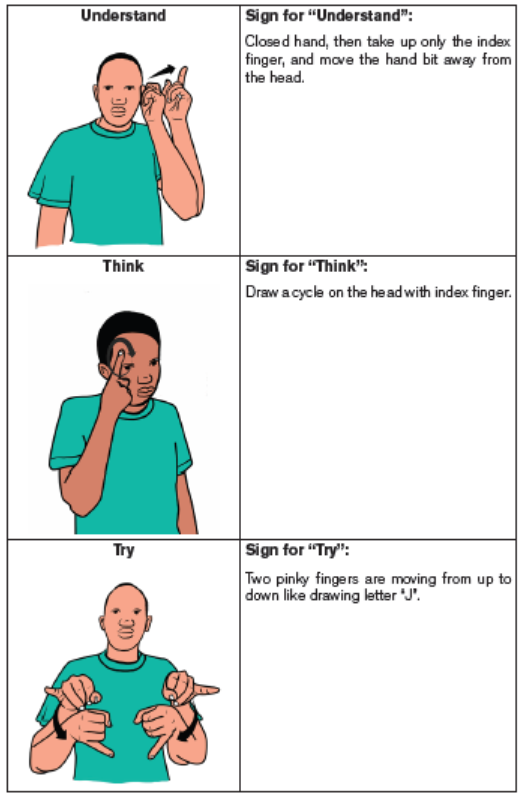
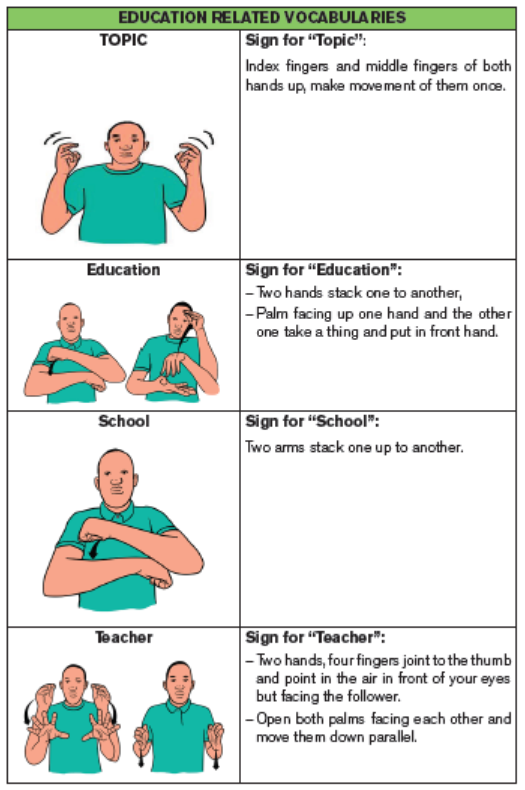
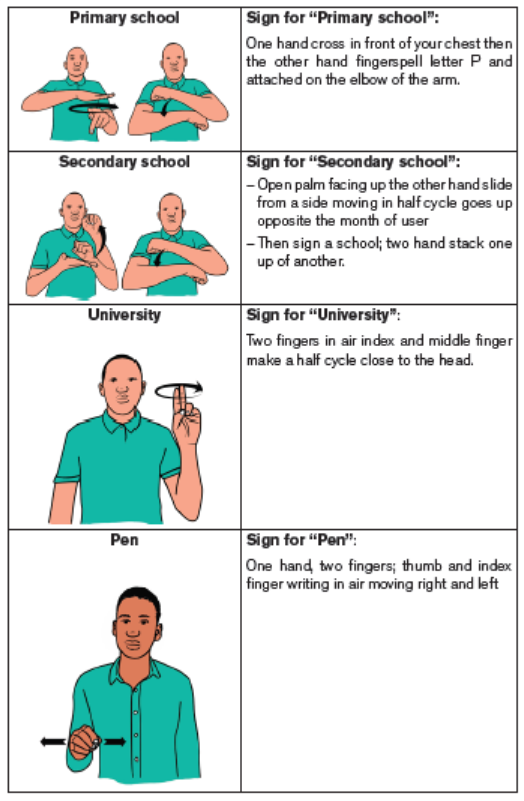
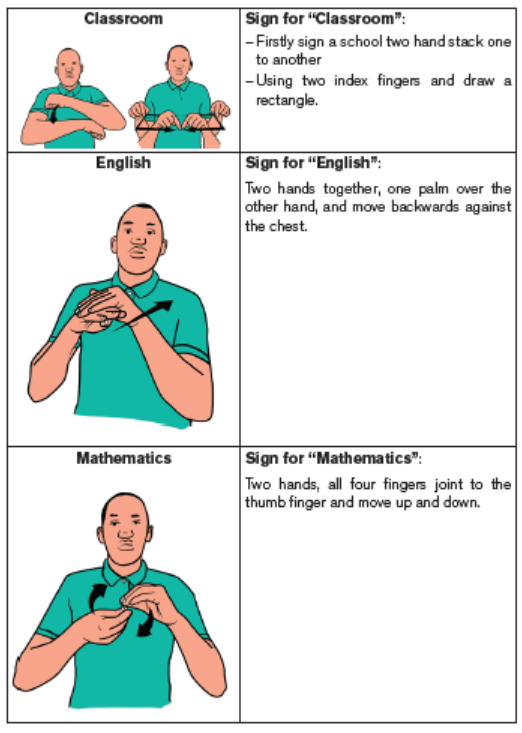
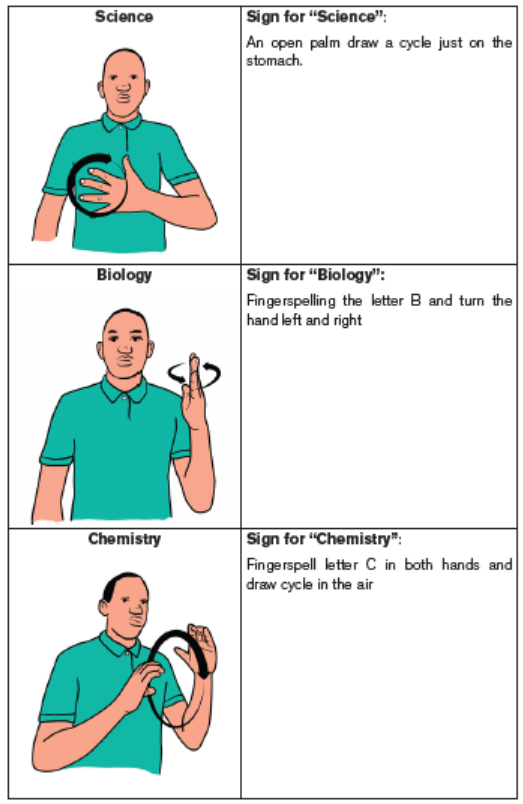
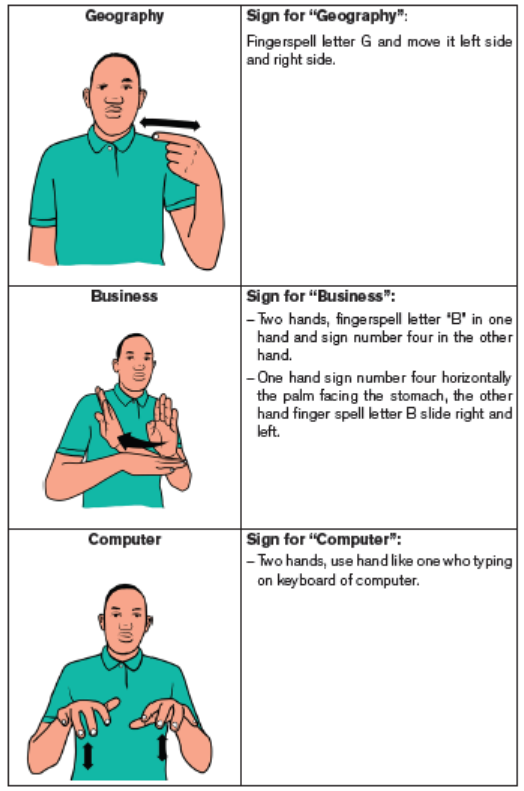
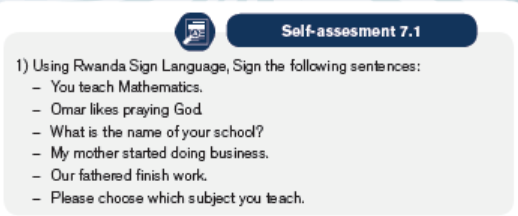
7.2. Sign Language Grammar Rules
a) Elements of Signs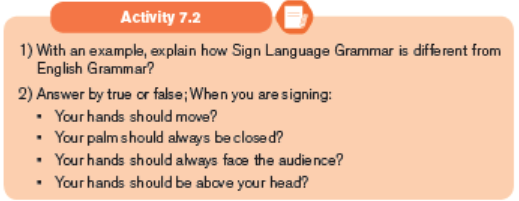
There are four elements of signs, they include:
1. Hand shape
2. Place of articulation (location)
3. Orientation
4. Movements
• Hand shape:
There are different hand shapes in Rwandan Sign Language which includes:
– Extended index finger: Place the tips of index finger on the lips move
them toward and backward alternatively. Eg: Same, What.
– Open palm: Eg: My/Mine (open palm placed in the chest), please, yours,
your, welcome, how, etc.
– Clow hand: Eg: Animals.
– "A” shape: Eg: Amen, well, which
– “C” shape: Eg: Church, Christ.
– Clenched Fists(S): Eg.: Yes, Sorry, love
• Place of articulation(Location):
This is the location of the handshape in the relation to the body. Signs are
made in specific places either on the body or in the space.
• Orientation
It is the direction of the palm in relation to the body of the signer. When two
people are signing you notice that some sign are made with the palm facing
the signer or others face different direction.
• Movement
Movement is how your hands moves from one location to the other.
b) Relationship between Elements of a Sign and Meaning.
Different elements of a sign have to combine so as to form in a specific
sequence in order to form a meaningful sign.
E.g: In order to make a sign for please, the elements have to combine
sequential as follows:
– Hand shape: Open palm
– Place of articulation: Chest
– Orientation: Open palm with fingers resting on the chest.
– Movement: Circular movement (clockwise).
Making a sign of talk, the elements have to combine sequential as follow:
– Hand shape: Extended index fingers
– Place of articulation: In front of the lips
– Movement: Alternate movement forward and backward
Note: If you change any of the elements, you are likely to change also the meaning
as well.
c) Rwandan Sign Language Grammar
Sign Language has its own grammar system, separate from that of English.
What this means is that sign language grammar has its own rules for phonology,
morphology, syntax, and pragmatics.
• Sign Language Word Order
Sign Language follows several different “word orders” depending on what is
needed. Which word order you choose depends on your audience’s familiarity
with the topic and what you are trying to do: explain, remind, confirm, negate,
cause or consider.
Normal conversations tend to follow Subject-Verb-Object or Subject-Verb
order. Some people might confuse this as to mean English word order. While
the word order in Sign Language and English can be similar, Sign Language
does not use “be” verbs (am, is, are, was, were) or anything to indicate the state
of “being.” Nor does it use articles (a, an, the). These are some distinctions to
keep in mind.
Eg: instead of signing i am happy, in SL they may just sign; “i happy”
Additionally, we also use Time-Subject-Verb-Object or Time-Subject-Verb word
order. That is, when discussing past and future events we tend to establish a
time-frame before the rest of the sentence.
Eg:
– Last week, I read my book
– Next week, will read my book
• Object, Subject Verb Word Order:
The fact is, like English, there are a variety of “right ways” to use sign language.
You can use more or fewer words and rearrange them depending on the context
of your sentence and what you want to emphasize. To ask the equivalent of
“Are you a nurse?” you can sign in any of the formats:
– You a nurse?
– A nurse you?– You nurse you?
7.3 Approaches of teaching and learning for Deaf and hard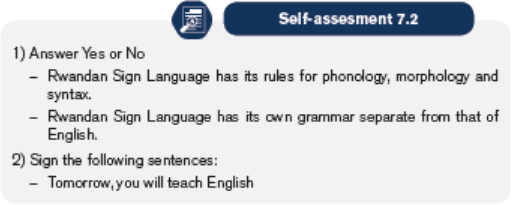
of hearing learners in an inclusive school
a) Techniques/rules for communicating with Deaf persons
• Maintain eye contact when talking to Deaf learner.
• Always face the source of light for visibility
• Do not talk while the face is turned away
• Keep your face at the same level with the Deaf learner
• Try to use the upper part of your body.
• Do not be more than 2 meters away from the Deaf learner
• Do not cover your mouth while speaking
• Speak naturally without exaggerating lip movement
• Consider the hand shape.
• Eye brow movements: Facial expression, body movements
• Simultaneous communication: Sign Language, Speech Reading, lip reading.
b) Mode of communication for Deaf and hard of hearing learners
During teaching and learning process, it became a problem in the selection
of the best communication mode to use since there is such a wide range of
students, each with their own abilities. Along with this is the severity of each
student’s hearing loss. Some suffered from only slight amount of hearing
loss and can therefore have better verbal communication skills, while some
were completely Deaf and have no way to communicate except through
sign language. There is persistent controversy regarding the best methods
for teaching students with hearing impairments. Research has shown several
different communication approaches, which can be used for effective teaching
and learning activities in schools for hearing impaired.
The following are most appropriate mode(s) of communication to use during
teaching and learning activities, in order to reduce communication problems
being experienced by Deaf learners:
i) Rwandan Sign Language(RSL)
Most Deaf persons in Rwanda communicate with each other and with hearing
persons using RSL. Rwanda Sign Language is manual communication
(primarily hand and arm shapes, positions, and movements) in the form of
signs used as a language with a grammatical structure different from the
structures of spoken languages. This sign language is accepted language
for the Deaf in Rwanda as Kenyan Sign Language is for Deaf persons in
Kenya; American Sign Language (ASL) is for Deaf persons in United States
of America and Canada, and British Sign Language (BSL) for Deaf persons
in Britain. There is no universal sign language and therefore signing systems
differ from one country to another. The downside to these sign languages is
that there is no use of sentence structure, making it difficult to have proper
grammar construction.
The Deaf community in Rwanda developed Rwandan Sign Language
(RSL). It is a visual gestural language, which bypasses the auditory channel
and allows visual reception of complex communication. RSL is a complete
language with its own vocabulary and complex syntactic, semantic and
pragmatic structures that are radically different from those of English or
any other auditory-oral language. It is the native language of Deaf children
whose parents are Deaf whom are often known by the acronomy CODA,
which means Child Of Deaf Adult. These children learn RSL in a fashion
remarkably similar to the language learning of normally hearing children
whose parents speak.
Benefits and limitation of Rwandan Sign Language
RSL is a fast means of communication if both the user and receiver are
proficient. It can be read from a distance hence, and it is appreciated
to not make any noise especially in the public places; it can be used in
churches, professional meetings, ceremonies and courts. It facilitates social
interaction by Deaf persons, and lessens the eyestrain involved in-reading
endless finger spelling. RSL is not grammatical hence, knowledge and use
of it does not improve English usage. Signs are limited in number compared
with the vast vocabulary of the English language. Signs are known and used
by a small minority of people.
ii) Fingerspelling
The public often confuses fingerspelling with sign language. Fingerspelling
is a means of representing the twenty-six letters of the alphabet and also
the Arabic numerals of written English by one-to-one correspondence
between written letters and hand and figure configurations and movements
representing the letters/numerals. This enables one to write a certain word
in the air with hand configurations and movements similar to writing on paper
with the written alphabet. Fingerspelling alphabets are not naturally and
spontaneously created by Deaf people themselves, but are the conscious
inventions of hearing educators. Both one-handed and two-handed
alphabets are in use, for example the BSL (British Sign Language) is two
handed fingerspelling, and Rwanda has adopted one-handed fingerspelling
system, here the user would prefer the dominating hand to use while doing
fingerspelling. Fingerspelling is used as both a self-contained means of
communication, and an adjunct to sign language.
Benefits and limitation of Fingerspelling
Fingerspelling is English or representation of any language with which it
is used. There is no limitation to the number of words that may be spelt.
Fingerspelling tires the reader if read for a long period of time. It is difficult to
read from a distance. Only very few people know and can read fingerspelling.
Fingerspelling cannot help a Deaf person who has not learnt the language
nor known how to read and write.
iii) Total Communication approach
Total communication (TC), is the title of a philosophy of communication,
not a method. Total communication may involve one or several modes
of communication (manual, oral, auditory, and written), depending on the
particular needs of the student. The original expectation of TC was for
teachers to use the communication method(s) most appropriate for a
particular student at a particular stage of development. Therefore, there
would be situations when spoken communication might be appropriate, other
situations where signing might be appropriate, others that would call for
written communication, and still others where simultaneous communication
might work best. Families and educators may use TC. Since more than 90
per cent of parents of children who are Deaf have hearing themselves many
believe that TC is a philosophy that will allow flexibility without eliminating
any of the options. By using a total approach of speaking and signing, all
members of the family, those who are Deaf as well as those who are hearing,
have continuous access to the communication occurring in their environment.
Teachers may choose to provide TC options in their classrooms. Those who
choose this approach have the responsibility and obligation of acquiring the
skills necessary to meet all of the student’s communication needs.
Benefits and limitation of Total Communication
The main benefit of TC is that it can open all avenues and modes of
communication for the Deaf child. Parents and teachers might be reluctant
to choose one mode of communication over another. TC, however, allows a
variety of combinations. TC is beneficial because it allows the student to use
the form that is best for him or her in any given situation.
One limitation of TC is that, while the theory may be sound, it may not be put
into practice accurately enough in some situations. Many students who are
Deaf are immersed in a form of simultaneous communication that does not
match their level of linguistic readiness or ability.
In the classroom, TC often becomes a simultaneous practice of combining
manual components (signs and fingerspelling) with spoken components
used in English word order. Although TC educational approach will differ on
the selection of a manual system, all seem to combine signing with speech.
The very nature of the two modes (spoken and visual) may cause signers or
speakers to alter their messages to accommodate one or the other mode,
causing a compromise between the two methods. It may be impossible for
one teacher to meet all the communication needs that might be present in
a single classroom of children who are Deaf and hard of hearing.
iv) Auditory Oral approach
The auditory-oral approach is based on the fundamental premise that
acquiring competence in spoken language, both receptively and expressively,
is a realistic goal for children who are Deaf or hard of hearing. Further, this
ability is best developed in an environment in which spoken communication
is used exclusively, which includes both the home and the classroom.
Teaching students to use whatever hearing they have to further the
acquisition of spoken language is basic to the auditory-oral approach.
Four levels of listening skill are detection, discrimination, identification,
and comprehension. Because the purpose of developing listening skills is
to further spoken language competence, speech is the primary stimulus
used in listening activities. Given current amplification technology (i.e.,
powerful and flexible hearing aids, FM systems, cochlear implants), it is
reasonable and realistic to expect most children with hearing loss to hear at
conversational levels. This makes an auditory-oral education a possibility for
the large majority of such children, given appropriate support.
Benefits and limitation of Auditory oral approach
The primary benefit is being able to communicate directly with a wide
variety of individuals. This ability brings with it options in terms of education,
vocation, and social life. Use of this method enables the hearing-impaired
child learn language by putting together what they see on the speaker’s lips
and what they hear through their residual hearing with the help of a hearing
aid.
As with every approach to educating children who are Deaf or hard of
hearing, not all children will be successful. Unanswered questions remain
about auditory functioning (even some hearing children cannot use their
hearing well), language processing (some children may also have additional
language disorders), and learning styles (some learning styles inhibit theattention and vigilance needed to develop orally).


